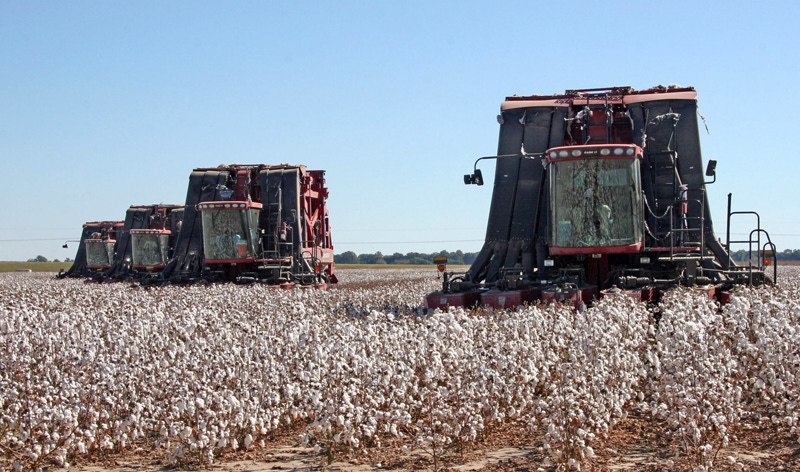
As many as 3 million to 4 million bales of cotton have been replaced with polyester in response to record high prices in 2010-11.This amounts to a 2 percent to 3 percent change in the cotton-to-polyester blend percentage.Whether the cotton market regain this demand will be an important issue in the coming months.

Whether high cotton prices of 2010-11 deferred cotton demand, or destroyed a portion of it, is an uncertainty the cotton market will tackle in the coming months, according to Joe Nicosia, CEO of Allenberg Cotton Co., featured speaker at the Cotton Roundtable in New York City in July.
Nicosia said during the event held at the Intercontinental Exchange in Manhattan that 3 million to 4 million bales have been replaced with polyester in response to record high prices in 2010-11. It amounts to a 2 percent to 3 percent change in the cotton-to-polyester blend percentage.
“Now that cotton prices have fallen back and are much closer to polyester prices, will some of this demand come back to cotton? Or will consumers find manmade fibers acceptable now that they’ve tried them in alternative applications. How much has been deferred and how much has been lost?”
Nicosia said the market performed as it needed to in 2010-11 with prices climbing high enough to produce “a needed downward shift in the demand curve for cotton to get us through extremely tight stocks.”
High prices shrunk demand by about 7 million bales — to around 113 million bales — to match the smaller supply, Nicosia said. Now the market has three issues to resolve — regain its market share from polyester through either consumer demand or price; regain overall demand hurt by the high prices; and figure out how to regulate the market in 2011-12.
On the latter, Nicosia said, “If prices get too low versus corn, wheat and soybean prices, which are substantially higher, we know what will happen to our cotton acres. The market must be careful to not make the same mistake it made in 2006-09 when we lost 40 percent of our cotton acreage, and then we had the largest bull run in history.”
As for supply, Nicosia said the world has planted enough cotton acres this year “to handle a disaster of the proportion it has seen in Texas, but it cannot handle a second one. If production in the United States varies 5 percent to 10 percent up or down, we believe the outcome in prices could be as much as 50 cents. In that type of scenario, we think it is very prudent for growers to maintain upside insurance via use of the options market by buying calls once they have sold their crop.”
The foreign area response to prices this year “has also been outstanding,” Nicosia said. Worldwide, Nicosia expects a 10 percent increase in cotton acres to about 93 million acres, possibly the highest in history “and a fitting response to the price action we’ve seen over the past year.
“French West Africa is going to see a 17 percent increase in cotton area and in Greece and Turkey, a 27 percent increase. In China, although their response has been more muted, they are expecting a 7 percent increase. India’s cotton area has responded by over 10 percent for a 3 million-acre increase this year.”
Nicosia says that India will grow a 29 million-bale crop this year, but since they consume only 20.5 million bales, “this will leave them as a formidable competitor in the foreign market.”
Another question is whether India’s protectionist tendencies will again provide opportunities for U.S. exports. Last season, Indian export bans along with a global shortage of cotton resulted in “one of the greatest runs in history in U.S. cotton export sales, along with one of the greatest runs in history for cotton prices.
“However, India does produce cotton very cheaply, and it will maintain and expand cotton area even at current prices. It is possible that in the next five years, India will be the world’s largest cotton producer and its exports will rival those of the United States.”
Intense competition will also come from Australia, which has good water supplies “and with cotton at near $1 a pound, it will grow 4.7 million bales, almost all of it for export. That’s a major departure from recent years in which production has been under 2 million bales.
“Brazil will also produce a very large crop, between 8.5 million to 9 million bales in 2011-12, while consuming only around 5 million bales with the balance for export.”
Nicosia noted that large unsold stocks in Uzbekistan and Turkmenistan from 2010-11 as well as the unsold new crop harvest “will also have to fight for export share.”
Nicosia reminded listeners that a year ago, cotton fundamentals and prices were relatively stable. “As the season began we were in recovery and on track to consume 120 million bales globally. But the combined disasters in Pakistan and China brought the world crop under 113 million bales, when stocks were already tight, causing us to have to destroy the use of 7 million bales. It took prices to over $2 a pound before that job was done. Inverses of almost 80 cents a pound provided the entire pipeline with the incentive to contract and suppress nearby spinning activity as much as possible. The destruction of demand caused large export sales cancellations and switches to polyester.”
As this year’s new crop becomes available, “the question is when will more normal spinning activity occur,” Nicosia said.
The Cotton Roundtable was sponsored by the Intercontinental Exchange, Certified FiberMax, Cotton Incorporated, Ag Market Network and Farm Press Publications.
About the Author(s)
You May Also Like





